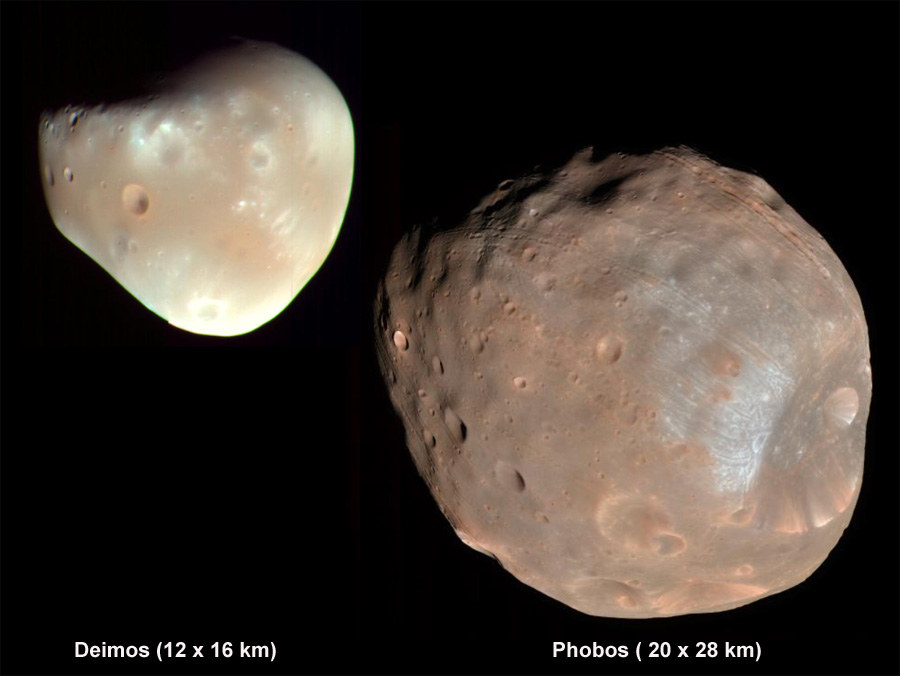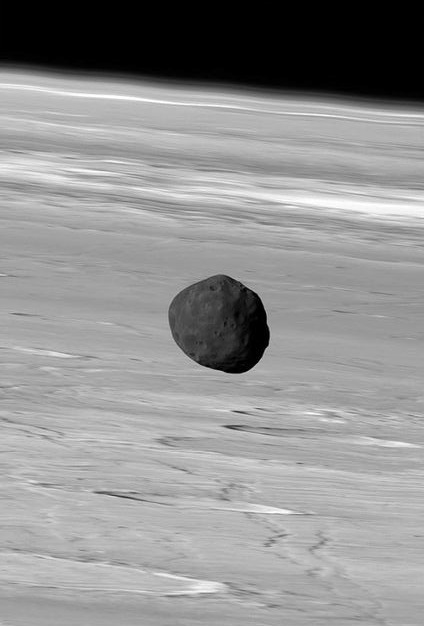
Color image of Phobos and Deimos to rough scale, obtained by Mars Reconnaissance Orbiter on March 23, 2008 and February 21, 2009, respectively.
What you’re seeing is the little Martian moon Phobos passing between the surface of the planet and the even smaller outer moon, Deimos, as seen from Gale Crater just a few degrees south of the equator. Phobos is only about 14 lumpy miles across, but it would distend about nine to 12 minutes of arc as seen from the Martian surface. The large apparent size and wide variance is because Phobos is so close, less than 4000 miles above the Martian equator, that the latitude of the observer substantially changes its apparent dimensions in the sky. Its so close it would be permanently below the horizon near the Martian polar circles.
For comparison purposes, from Gale Crater, Phobos would appear to be about one-third of the full moon or the disk of the sun as seen from earth, both of the latter distend on average about 30 arc minutes or one-half of one degree.
Deimos is about half the size of its brother and orbits about 14,000 miles away, making it barely discernible as a misshapen disk by a sharp-eyed Martian observer standing next to Curiosity. It would distend about 2 arc minutes, hardly much larger than Venus’ disk at its closest approach to earth. But Curiosity’s mast cam picks them both up surprisingly well in the video.
They both look pretty tiny and harmless in the clip. But Phobos and Deimos are well named after the Greek gods of panic and terror respectively, for more reasons than mythological association with Mars, the Roman god of war. You want see how freaky danger-scary this arrangement really is? There’s Phobos below with Mars underneath for scale as seen by Mars Express (I think anyway, I’m not 100% sure of that). If that thing was suddenly hanging like that a mere few thousand miles above earth we’d probably be in a global panic and rightfully so. Any space-faring nuclear nation would be able to send giant shards of that sucker, maybe even the whole thing, down on us if they were properly dedicated mad scientists.

Both diminutive moons are thought to be captured asteroids and look the part. Although how exactly that would happen is a subject of debate among orbital mechanics. Phobos is quite dim, not much brighter than light charcoal. Deimos is a tad brighter and a little whiter. The weirdness starts right away: Phobos completes an orbit every seven and a half hours, Deimos about every 30 hours. Because Mars rotates once every 24 hours and change, Phobos would rise in the west and set in the east every 11 hours.
This dynamic means Phobos is being robbed of orbital velocity and is on a death spiral. It is thought to be a self-gravitating pile of rubble and will likely disintegrate long before hitting the tippy-top of the rarefied Martian stratosphere, but without knowing more about its internal structure and composition it’s hard to say precisely when this will occur. Sometime in the next 10 million and 100 million years, with highest probability being centered between 35 and 45 million years, it will be torn into ribbons of debris, perhaps much brighter than the dull surface, which independently burn in over the subsequent millennia like a thousand chunks of Shoemaker-Levy 9 in miniature slo-mo.
We’d be able to watch that debris light up the surface like an arc welder and leave angry glowing marks where they hit. It would be quite a sight to see even through a telescope, and it may not be the first time its happened. There are features on the surface consistent with a similar fate for other bodies roughly the same size in the distant past. Which kind of makes one wonder exactly what might have been captured originally, if that object or objects broke up under tidal forces and reformed multiple bodies of which these two are merely the last survivors, or if something similar hasn’t happened to earth over the eons too …
Because of its 30 hour orbit, Deimos would rise in the east and set in the west abuot once every three days, which is more like a decent astronomical object should behave! Thus, much like our own moon, it is being accelerated to a higher, longer orbit. Given enough time it would eventually leave the Martian sphere of influence, only to become a serious threat as a Near Mars Object afterward. Future interactions with Mars might result in impact, kicking it into the inner solar system, or flinging it out toward the asteroid belt and beyond. I don’t know for a fact, but just looking at it and knowing something about the earth-moon dynamic, it’s my wild guess Deimos wouldn’t be hypothetically free to meet one of those fates until after the sun sheds its outer layers as a planetary nebula and becomes a white dwarf, so it might be a moot point.
Phobos and Deimos each have such miniscule gravity you could jump a hundred feet high or fly over their surfaces like Buck Rogers with a sporty little jetpack for hours on a few kilos of fuel. You’d have to go to Saturn to find equally strange objects in close orbit around a major planet. And to make them weirder still, each is thought to be so porous they would have to contain substantial voids, perhaps thousands of bubbles the size of a cozy room or a few giant cracks that could hide a fleet of spaceships, or they may harbor large reservoirs of low density material like frothy frozen water or other ices, or all of the above.
They are both good childhood friends of mine and yet they both remain delightfully weird, mysterious objects to this day. No matter what they are made of or how they got where they are, Phobos and Deimos are both damn handy, natural space stations and supply depots just begging for a suite of scientific instruments as soon as possible. And one day, hopefully sooner rather than later, they can act as sanctuaries and homes for future explorers and permanent residents alike.

Great article and clip here. Shared. Cheers DarkSyde.
Interestingly (well to me ) there’s also this fact :
about these Martian moons (or moonlets) too.
DarkSyde;
Why aren’t these small moons round(er)?
Susan, they are not large enough for the relatively rigid materials they are composed of to flow and assume a spherical shape like larger objects. In fact these guys are so small and the gravity so weak you could throw a baseball off them into space. On Deimos you could almost jump off of it even wearing a massive spacesuit.
Where you wrote “distend” I believe you meant “subtend”.
It occurs to me that if there were a technological species on Mars, their Moon Shot would be a heck of a lot easier!
As a Wyoming native (now, sadly, ex pat), I can appreciate your using its night skies as a standard. I lived a couple thousand feet above those deserts in the Wind Rivers. On a clear winter night the Milky Way can appear to be almost solid and the sheer number of naked eye stars come as a shock to visitors from the low lands.
Very nice post, DarkSyde. Thanks.